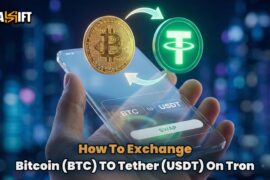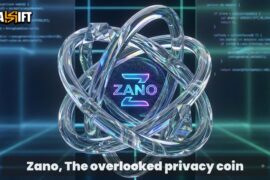- What Is NFT?
- How Does an NFT Function?
- Are NFTs safe?
- How to Buy & Store NFTs
- In conclusion
- FAQs
- 1. What is an NFT?
- 2. How is an ERC‑721 NFT different from a fungible token?
- 3. Can I store NFTs in any crypto wallet?
- 4. How do I buy NFTs on marketplaces like OpenSea or Magic Eden?
- 5. What are the main risks involved in using NFTs?
- 6. What are phygital NFTs?
- 7. How do I avoid scams and protect my NFT investments?
Non-fungible tokens (NFTs) are unique digital tokens stored on a blockchain, most commonly Ethereum. They act as immutable certificates of ownership for digital assets like art, music, virtual land, and more by referencing unique metadata. Unlike cryptocurrencies (e.g., Bitcoin), each NFT is distinct and irreplaceable.
In this updated 2025 guide, Flashift will explain how NFTs work under the hood from ERC‑721 and ERC‑1155 standards to metadata and minting processes. We also explore emerging trends such as utility and phygital NFTs, legal considerations, and step-by-step guidance on buying, trading, and storing NFTs through platforms like Flashift.
What Is NFT for?
The most ordinary use of NFTs falls to the lot of digital art: authors are entitled to issue their works as NFTs and then sell them to collectors. In turn, the latter become the owners of rights to the original file, though the work may well remain open for being viewed free by everybody online. In fact, artist Beeple made history in 2021 when his digital art “Everydays: The First 5000 Days” sold to an NFT for $69 million in an auction. The musicians also started releasing exclusive tracks or albums as NFTs whereby the owners will get the opportunity to own a rare piece of music history.
Besides art and music, NFTs find their application in domains of gaming and virtual worlds. Examples that could be imagined in video gaming contexts are skins, weapons, characters, or other types of virtual ammunition or rewards that a player can purchase, sell, or trade to another. It introduces true ownership into digital spaces for the very first time in this industry, where actual owners of their in-game assets are independent of the ecosystem of the game. The NFTs are also being issued to sell digital land on the virtual worlds of Decentraland and The Sandbox, thereby allowing users to buy, sell, and develop their pieces of land.
While NFTs hold great promise, challenges persist. Some critics pointed out that blockchain can be dire for the environment due to the network energy consumption, such as that by Ethereum. Speculation, that had firmed up in the NFT marketplace, brought an unstable nature of prices with it-some NFTs sell for fantastic figures, while others become worthless in no time. Leaving aside all the above issues, NFT really is a huge innovation in how we handle digital ownership and open up completely new opportunities for both creators and collectors.
What Is NFT?
Non-fungible tokens (NFTs), cryptographic commodities underpinned by the immutable blockchain framework, possess unique identifiers and metadata, distinguishing each token unequivocally from its counterparts. These digital assets, imbued with singular characteristics, transcend conventional exchange paradigms.
NFTs navigate a fluid marketplace, enabling transactions for fiat currency, cryptocurrencies, or other NFTs, contingent on prevailing market dynamics and perceived ownership value. For instance, within a digital trading ecosystem, one might monetize an NFT depicting a banana image, converting it into digital currency. Market participants exhibit disparate valuations—some may invest substantial sums for the NFT’s acquisition, while others might deem it devoid of intrinsic worth.
what is DeFi and how does it work?
Tokens are also used for cryptocurrencies; nevertheless, the key distinction is that two coins from a single blockchain are interchangeable—they are fungible. Although two non-fungible tokens from the exact same blockchain may appear the same, they are not convertible.
How Does an NFT Function?
Non-fungible tokens (NFTs) reside on a blockchain, an open and distributed database that meticulously records and stores transactional activities. You’ve undoubtedly encountered blockchain technology, the foundational framework enabling the existence of cryptocurrencies. While NFTs are predominantly housed on the Ethereum blockchain, their presence is not confined solely to this platform—they can also inhabit other blockchain ecosystems.

An NFT is “minted” using digital files that reflect elements that are tangible as well as intangible, such as:
- GIF Animations
- Artifacts
- Sports clips and highlights, documentaries and movies
- Antiques
- Video game graphics and avatars that are virtual
- Designed shoes
- Songs of different genres
The dark side of Cryptocurrency; security and privacy concerns!
NFTs are generated by a procedure known as minting, wherein the NFT’s data is stored on a blockchain. At the highest level, the minting procedure involves creating a new block, validating non-fungible tokens data with a validator, and closing the block. This minting procedure frequently includes the incorporation of smart contracts which allocate control and ownership to the non-fungible token’s adaptability.
Tokens are issued with an identification number that is directly connected to a blockchain location. Each token has an owner, and the owner’s data (i.e., the address where the generated token is kept) is accessible. Even if 5,000 NFTs of a single product are issued (equivalent to free-of-charge movie tickets), each token has its own unique identity.

Are NFTs safe?
Non-fungible tokens, like cryptocurrencies, that utilize the technology of blockchain are typically hard to penetrate. The weakest link in all blockchains, nevertheless, is the key to your NFT. The program that saves the keys may be compromised, and the gadgets on which the credentials are stored can be lost or destroyed, therefore the bitcoin blockchain adage “not your keys, not your coin” holds to both NFTs and Bitcoin. non-fungible tokens are safe if your keys are appropriately guarded.
top ten most eco-friendly cryptocurrencies 2023;
The most obvious advantage of NFTs is the effectiveness of the market. Tokenizing an actual product can help to speed sales procedures and eliminate the need for intermediaries. non-fungible tokens on a distributed ledger reflecting digital or physical paintings could remove the requirement for agencies and allow merchants to interact personally with their intended consumers (provided the creators know how to safely host their NFTs).
How to Buy & Store NFTs
Buying and storing NFTs involves three essential steps: choosing the right marketplace, using a compatible wallet (with Flashift-friendly integration), and following best practices for security and minting.
NFT Marketplaces (OpenSea, Magic Eden)
-
OpenSea is the world’s largest NFT marketplace, supporting Ethereum, Polygon, and Klaytn networks. You can bid, buy, or sell NFTs directly through your connected wallet.
-
Magic Eden is popular on Solana. After connecting a compatible wallet, simply click “Buy Now” or place an offer; confirm with your wallet to complete the purchase
Compatible Wallets & Flashift Integration
-
Most NFT wallets integrate seamlessly with marketplaces. Popular options include MetaMask, Trust Wallet, Coinbase Wallet, and AlphaWallet
-
Hardware wallets like Ledger and Trezor offer added security for long-term NFT storage.
-
On Flashift, you can securely link your external NFT wallet to view or initiate trades, using the same seed phrase standards for authentication and asset visibility.
Safe Practices for Minting & Reclaiming
-
Minting NFTs: Always preview metadata before approving. Check royalties, purchase fees, and gas costs.
-
Storage: Keep high-value NFTs in hardware wallets and only connect for transactions.
-
Recovery: If your signed NFTs aren’t visible in your display app, refresh metadata or sync your wallet. If an error occurs, double-check wallet compatibility and reconnect.
In conclusion
Non-fungible tokens are a development of cryptocurrency’s very straightforward premise. Modern financial systems are made up of complex dealing and financing platforms for many asset kinds, such as property, lending agreements, and artwork. non-fungible tokens advance the reconfiguration of this framework through the provision of electronic representations of commodities.
how to know the best time for investing in cryptocurrencies?
To be clear, neither the concept of digital pictures of physical goods nor the application to distinctive identity is revolutionary. When these ideas are paired with the advantages of a tamper-resistant blockchain, intelligent agreements, and automated processes, they constitute a powerful force for change.
FAQs
1. What is an NFT?
An NFT (non-fungible token) is a unique digital asset stored on a blockchain, used to prove ownership and authenticity of digital or tokenized real-world items. Unlike cryptocurrencies like Bitcoin, each NFT is distinguishable and cannot be replaced one-for-one.
2. How is an ERC‑721 NFT different from a fungible token?
ERC‑721 defines non-fungible tokens with unique IDs and metadata, making each token distinct. In contrast, fungible tokens (like ERC‑20) are identical and interchangeable. ERC‑721 was formalized in 2018 and powers many high-profile NFT.
3. Can I store NFTs in any crypto wallet?
Yes, but only compatible wallets can display NFTs correctly. Common options include MetaMask, Trust Wallet, Coinbase Wallet, and hardware wallets like Ledger and Trezor.
4. How do I buy NFTs on marketplaces like OpenSea or Magic Eden?
First, set up and fund a compatible wallet. Then choose a marketplace, connect your wallet, and complete a purchase or place a bid. Platforms will guide you through metadata previews and transaction approvals.
5. What are the main risks involved in using NFTs?
NFTs don’t always confer copyright. Their metadata may be vulnerable to link rot, and many projects carry speculation or fraud risk. Smart contract exploits and scam collections are also common
6. What are phygital NFTs?
Phygital NFTs combine digital tokens with real-world assets—like pairing digital artwork with a physical print or a concert ticket with experiential benefits. They bridge physical ownership with on-chain proof, becoming a growth area in 2025 .
7. How do I avoid scams and protect my NFT investments?
Always verify projects for authenticity, use hardware wallets for storage, check smart contract metadata, and be wary of unsolicited links. Educating yourself is essential—major brands now include clear user FAQ guidance .







